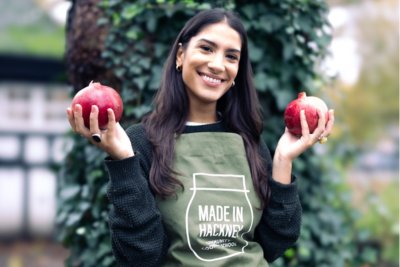Real Bread vs. ultra-processed food
Real Bread Campaign co-ordinator Chris Young says (once again): not all loaves are created equal.

As health concerns around ultra-processed food (UPF) grows, fingers are often pointed at ‘bread’ (by which they mean additive-laden industrial dough products) as one of the prime suspects. This can lead to people damning Real Bread by (inappropriate) association.
Reclaim the name!
As I’ve been saying for nearly a decade and a half: not all loaves are created equal. It’s time to sever the conceptual link with additive-laden industrial dough products by reserving the noble name of bread for, well, bread.
Rather than ‘factory bread’, ‘supermarket bread’, ‘plastic bread’, ‘shop bread’, ‘sliced bread’, ‘white bread’, ‘cotton wool bread’ and so on, let’s call additive-laden articles industrial dough products (IDP) for now. We can leave the multi-billion-pound industrial dough fabrication sector’s well-paid marketing agencies to come up with an appropriate name for what they manufacture.
With that said, let’s turn our attention to some of the questions and concerns that hang over UPF in general and IDP in particular.
What is ultra-processed food?
Much of the food consumed around the world is processed in some way or another, but there is a vast difference between a boiled potato and a Pop Tart.
Deciding that more nuance was required than the binary categorisation of food as either unprocessed or processed, in 2009 a group of researchers in Brazil, led by Carlos Monteiro, published A new classification of foods based on the extent and purpose of their processing.
This was developed and subsequently named The NOVA Food Classification. Since then it has been adopted, or at least recognised, by many organisations and health professionals around the world, including the United Nations and the World Health Organisation.
NOVA classifies foods into four groups:
- Unprocessed and minimally-processed.
- Processed culinary ingredients.
- Processed.
- Ultra-processed.
Focusing on baking, examples of foods in each of these categories include:
- Whole grains, flaked grains, flour,* yeast, eggs.
- Salt, butter, oils.
- Real Bread, as defined by the Campaign.
- IDP, such as the Chorleywood Process loaf.
*Wholemeal and refined flours, including those with so-called fortificants added.
Real Bread is a processed food?
Yes, as noted above, Real Bread is a processed food. Rather than growing on plants, roaming on land or swimming about, before being harvested or caught, then eaten more or less as it’s found, Real Bread is crafted from unprocessed and minimally processed ingredients.
The Campaign defines Real Bread as made without chemical raising agents, so-called processing aids or any other additives. This universally-inclusive definition encompasses every type and style of additive-free bread and there’s no limit to the number of natural / minimally-processed ingredients that can be used.
What about IDP?
IDP take things further from nature into the UPF category. Depending on whether or not you believe industry figures, perhaps around 80% of products sold as ‘bread’ in the UK are made by The Chorleywood Process. This involves high speed mixing, larger doses of baker’s yeast than Real Bread bakers use and (key to the UPF categorisation) any number of additives, some of which (so-called processing aids) don’t have to be declared on the label. In this process, the time that dough is allowed to ‘ripen’ through fermentation is much shorter than most Real Bread making and a fraction of that needed to make genuine sourdough.
IDP also include many pre-packed pizzas and bagels; as well as those flatbreads, rolls and whatnot you find in hermetically-sealed packaging, with a shelf life of weeks or months. Some of the products you find in supermarket ‘bakery’ sections (and even in some high street bakeries) are IDP as well. It’s very hard to be sure which unwrapped products are and aren’t UPF as, unlike pre-packed food, retailers don’t have to display full ingredients lists for them (only a declaration of certain allergens), something we’re working to change through our Honest Crust Act work.
While performing profitable functions in mass production and retail systems, so-called processing aids and other additives used in IDP are unnecessary by definition, as is clearly demonstrated by bakers who craft Real Bread from as few as three ingredients.
Trade bodies and other apologists for IDP loaves, flatbreads, buns and so on say things along the lines of: ‘all bread is real bread’ and ‘our products are basically the same, just with a few added extras to help things along.’ So, by that measure, is a runner on steroids ‘just to help things along’ the same as a real athlete?
How can I tell if it’s UPF?
We should ask our friends at Balcony Shirts to print t-shirts with this: Always read the label!
The ‘packaged bread’ vs. ‘unpackaged bread’ distinction that many sources suggest is not a failsafe one. Some bakeries sell Real Bread in sealed bags, while supermarkets (and others) sell unpackaged IDP. Whatever claims are made in adverts or in big, friendly letters on the front of a pack (perhaps especially if it has any of those) always flip a product over to read what it says on ingredients list, quite possibly in the smallest font size permitted by law.
If there isn’t an ingredients list (back to those unpackaged products again) you can try checking the company’s website or asking a member of staff to get a copy for you. If my experience is anything to go by, you might have to wait a while. If the list includes an E number (or additive* by any other name) the product is UPF.
While there is some overlap with foods that are high in fat, salt and sugar (HFSS), not all UPF are HFSS and vice versa. Think of those low-fat or sugar-free versions of foods that use additives and modified substances in an attempt to compensate for the missing natural elements. Conversely, there are many wholesome, NOVA 1 and 2 category foods that are high in (or simply are) fats, sugars or salt.
*Again, the NOVA classification includes/allows flour with so-called ‘fortificants’ in its category 1: unprocessed and minimally-processed foods, as do we in our Real Bread definition.
What’s wrong with UPF?
It’s a sweeping generalisation, but there seems to be the tendency of an inverse relationship between the amount of processing a food undergoes and how healthy it is. There are of course many exceptions in both directions but, as an example, for most people stoneground wholemeal flour is a healthier option than highly-refined, roller-milled white flour. Another apparent general tendency is for the number of questions hanging over a food to increase as the amount of processing does.
As an article titled Ultra-processed foods: how bad are they for your health? published by the British Heart Foundation noted, “several studies have shown that eating higher amounts of ultra-processed foods is linked to a greater risk of:
- high blood pressure.
- cardiovascular disease.
- heart attacks and strokes.
- early death.
Researchers from Imperial College London’s School of Public Health collected data on the diets of 200,000 people, monitoring their health over 10 years. Their study found that higher consumption of UPF was associated with a greater risk of developing, and dying from, cancer.
More (ultra-processed) food for thought
Much of the current scrutiny of UPF includes the potential harms of UPF as a category, including the products, their manufacture and marketing. Also being scrutinised are the power, intentions and activities of the corporations behind them, as well as links between industry and regulators. I found Dr. Chris van Tulleken’s book Ultra Processed People a very readable overview of the issues. (Declaration of interest: he gives the Real Bread Campaign a couple of mentions in the book – thanks again!)
As Dr. Chris said to me: “it’s not just about the additives. It’s a system of production in which all the incentives are financial. Ingredients are as cheap as possible, formulations are as addictive and marketing as aggressive. Food is made to nourish people. Ultra-processed food is made to generate money for the institutional investors in trans-national food corporations and is now one of the leading causes of not just obesity but of all diet-related disease, including early death. Almost all the messaging to the contrary is funded by the ultra-processed food industry.”
A DATEM with death?
Am I being melodramatic? Yes, I’m being melodramatic. This is an emerging area of study, with an almost infinite number of combinations of factors under the banner of UPF. The BHF article advises caution when interpreting and quoting studies, and so do we. Nobody is suggesting that eating a slice or two of IDP will kill you instantly.
I think it’s still worth thinking about growing evidence that some of the additives commonly used in UPF (IDP in particular) might not be as harmless as industrial manufacturers and retailers would like us to believe.
Before an additive is approved for use in the UK or the rest of Europe, it has to be tested and deemed safe.* Typically this involves in vitro (test tubes, petri dishes etc.) and in vivo tests, often rodents or other animals. Ethics aside, it is questionable how translatable results of such tests might be to responses of the human body in general…and that’s before considering our individual microbiomes.
What aren’t tested are the effects that mixtures of additives (in combinations used in IDP, for example) might have on human health. What (if any) ‘cocktail effect’ of additives consumed across a diet that includes a range of UPF is a complete unknown.
Please also bear in mind that history is littered with additives that were once declared safe but later heavily-regulated, withdrawn or banned in the UK on health grounds. They include former IDP staples azodicarbonimide, potassium bromate and nitrogen trichloride.** In 1996, the EU’s Scientific Committee on Food set an Acceptable Daily Intake (ADI) of the preservative potassium sorbate at 25mg per kilogram of bodyweight per day. Then, following the 2015 Scientific Opinion on the re-evaluation of sorbic acid (E 200), potassium sorbate (E 202) and calcium sorbate (E 203) as food additives, The EFSA Panel on Food Additives and Nutrient Sources added to Food slashed the ADI to just 3mg of sorbic acid/kg bw/day.
Away from IDP (except perhaps a rainbow bagel, *shudder*) food containing any of 'The Southampton Six’ food colourings has to bear the warning: ‘May have an adverse effect on activity and attention in children’. There are some additives banned in the rest of Europe that are still legal in Britain: as recently as 2022 the EFSA concluded titanium dioxide is a possible carcinogen and the EC banned the substance to protect its citizens. This protection extends to Northern Ireland but the rest of us in post-Brexit Britain are still exposed to the white stuff while The Committee on Toxicity mulls it over. I digress, though…
*The ‘Generally Recognised as Safe’ (GRAS) approval process in USA (an “exemption has been stretched into a loophole that has swallowed the law.” ) is a whole different kettle of something-or-other…
**The first two of these are still permitted in the USA and some other countries.
Emulsifiers
I hope it’s obvious, but please note that what follows is not a systemic review or metanalysis of available data and literature. It’s merely a snapshot to highlight some of the questions and concerns that have been raised, and that more research is needed.
There is nothing wrong with emulsifiers per se – think egg yolk, cornflour and other unprocessed / minimally-processed ingredients that are used in cooking. It’s the category of industrially created or modified emulsifiers over which questions hang. Examples commonly used in IDP include sodium stearoyl lactylate (E481); mono- and diglycerides of fatty acids (E471); and (deep breath) diacetyl tartaric acid esters of mono- and diglycerides of fatty acids, aka DATEM (E472e).
The main concerns are that some emulsifiers might damage the human gut’s populations of beneficial microbes (the microbiome again) and its lining, even to the point of making it ‘leaky’. Between 2012 and 2014, the ‘long term effects of food emulsifiers on intestinal barriers’ and ‘food emulsifier, the gut microbiome and long term health effects’ were amongst issues evaluated by The European Food Safety Authority as part of its activities on emerging risks, though no further action was taken on either.
The authors of Direct impact of commonly used dietary emulsifiers on human gut microbiota concluded: “...most, but not all, emulsifiers tested here impacted human intestinal microbiota in the MBRA model. Importantly, various food additives are very often used in combination, and it remains important to investigate their effects in combination, especially for compounds with different impacts on the human microbiota. Thus, while future studies are warranted, these data nonetheless importantly suggest that clinical trials are needed so as to reduce the usage of the most detrimental compounds and to favor the use of emulsifying agents with no or low impact on the microbiota.”
Meanwhile, authors of Food additives: Assessing the impact of exposure to permitted emulsifiers on bowel and metabolic health - introducing the FADiets study noted: “Emerging in vitro and animal evidence suggests that food additives such as emulsifiers may contribute to gut and metabolic disease development through alterations to the gut microbiota, intestinal mucus layer, increased bacterial translocation and associated inflammatory response.”
Food additive emulsifiers and risk of cardiovascular disease in the NutriNet-Santé cohort: prospective cohort study noted that previous research “suggests deleterious effects of food additive emulsifiers on the intestinal microbiota and metabolome” and that “such effects can lead to chronic intestinal inflammation and increasing susceptibility to carcinogenesis, and potentially cardiovascular disease (CVD)”. The study “found positive associations between risk of CVD and intake of five individual and two groups of food additive emulsifiers widely used in industrial foods.”
Preservatives
Again, I’m not suggesting that all preservatives = bad. Vinegar, salt (in moderation) and lactic acid bacterial fermentation can all be used as natural preservatives. What we’re talking about here are some artificial preservatives.
Pick up an IDP and the chances are you’ll find the additive calcium propionate (E282) on the ingredients list. Published in 2021, Acute effects of the food preservative propionic acid on glucose metabolism in humans concluded: “oral consumption of PA leads to inappropriate activation of the insulin counterregulatory hormonal network. This inappropriate stimulation highlights PA as a potential metabolic disruptor.” This study also serves to underline that though a substance (in this case propionic acid) might occur naturally and cause harm, the effects of consuming an additive version of (industrially synthesised and used in greater quantity than found in nature) might be different.
Published in 2002, Controlled trial of cumulative behavioural effects of a common bread preservative reported: “Irritability, restlessness, inattention and sleep disturbance in some children may be caused by a preservative in healthy foods consumed daily. Minimizing the concentrations added to processed foods would reduce adverse reactions. Testing for behavioural toxicity should be included in food additive safety evaluation.”
Other tasty treats
Back in 2010, the Real Bread Campaign accepted that it was unlikely that any UK industrial dough fabricator would knowingly use L-cysteine hydrochloride (E920) of piggy, poultry or human origin. Synthetic versions, however, are still used in some IDP.
Effects of the Usage of l-Cysteine (l-Cys) on Human Health notes: “Despite the high volume of evidence describing positive impacts of l-Cys on human health, it is worth noting that the number of works describing no effects or negative effects is also significant. Negative effects of l-Cys derivatives on human health have been reported.”
…and then there are concerns around not-exactly-natural ingredients, such as partially-hydrogenated oils (PHO), solidified by artificial means and sold to bakers (and shoppers) in/as margarine, vegetable shortening or simply vegetable fat. Up until very recently, we were all told that PHO were ‘healthy alternatives’ to natural / minimally-processed animal fats such as butter, lard and dripping. We now know that PHO are packed with potentially heart-stopping levels of trans-fats, begging the question: how long has the UPF industry known this? The WHO called for governments to take action and many have (even the US FDA withdrew the GRAS status of PHO) but they're still at large in the UK.
Our mantra regarding the potential benefits of sourdough fermentation applies to all of the above as well: much more research is needed. In the meantime, we take the precautionary principle and encourage everyone to eat a delicious, nutritious staple food that people around the planet have been enjoying for thousands of years: Real Bread.
The costs of healthy and unhealthy food
A big issue for so late in an article, but: in general UPF is apparently cheap, while good food often costs more to buy. Is it really 'cheap food' though, or is it just less expensive at the till?
The true costs (variously in terms of the environment, animal and human health, and local economies) tend to be displaced and deferred to be paid somewhere, somewhen and perhaps by someone else, while shareholders pocket the profit. For example, much continues to be written and said on the costs of dietary ill health to the NHS (and therefore all of us as taxpayers), employers and the economy, as well as personal costs to the people affected and their families.
Conversely, good food tends to represent true value (decreased negative impacts and even increased positive ones) which are reflected by realistic, honest pricing.* I often use the comparison of a fully-automated IDP factory, mass-producing hundreds of thousands of loaves a day, and a small, local bakery, where a handful of skilled bakers hand-craft loaves in their tens or hundreds. The ‘efficiency’ of the factory helps to enable a cheap price at the till and good dividends for distant shareholders, while the ‘inefficiency’ of the artisan bakery helps to support more jobs-per-loaf, the local economy, and keeping the community’s high street alive.
The challenge is, how do all sectors of society work together to ensure that everyone has the funds and chance to buy good food, and how do we ensure those shareholders bear the true costs? These are huge, complex conversations that Sustain, and other organisations, continue to lead.
*Some small, independent producers/retailers might charge a premium over costs plus a fair profit, based on what people are willing to pay, but the same can be said for big players. How does a supermarket justify the markups on a ‘deluxe’ or ‘finest’ version of a Chorleywood loaf compared to its near-identical ‘standard’ and ‘value’ ones? Currently (October 2023) a ‘value’ 800g own-brand white loaf at Tesco is 45p, while they’re charging 95p (more than double) for their ‘premium’ one, with similar price hikes at other major retailers.
See also
Further reading
- What are we feeding our kids? (Children's Food Campaign blog post)
- Real Bread For All
- Bridging The Gap
External links:
- Scientific Advisory Committee on Nutrition (SACN) Statement on Ultra-Processed Foods and Health
- Food Active position statement on UPF
- Faculty of Public Health position statement on UPF
- First Steps Nutrition: Ultra Processed Foods in the Diets of Infants and Young Children in the UK
- Soil Association reports on UPF
- The UN Decade of Nutrition, the NOVA food classification and the trouble with ultra-processing
- Ultra-processed foods, diet quality, and health using the NOVA classification system
- Ultra-processed foods: what they are and how to identify them
Published Monday 23 October 2023
Real Bread Campaign: The Real Bread Campaign finds and shares ways to make bread better for us, better for our communities and better for the planet. Whether your interest is local food, community-focussed small enterprises, honest labelling, therapeutic baking, or simply tasty toast, everyone is invited to become a Campaign supporter.







